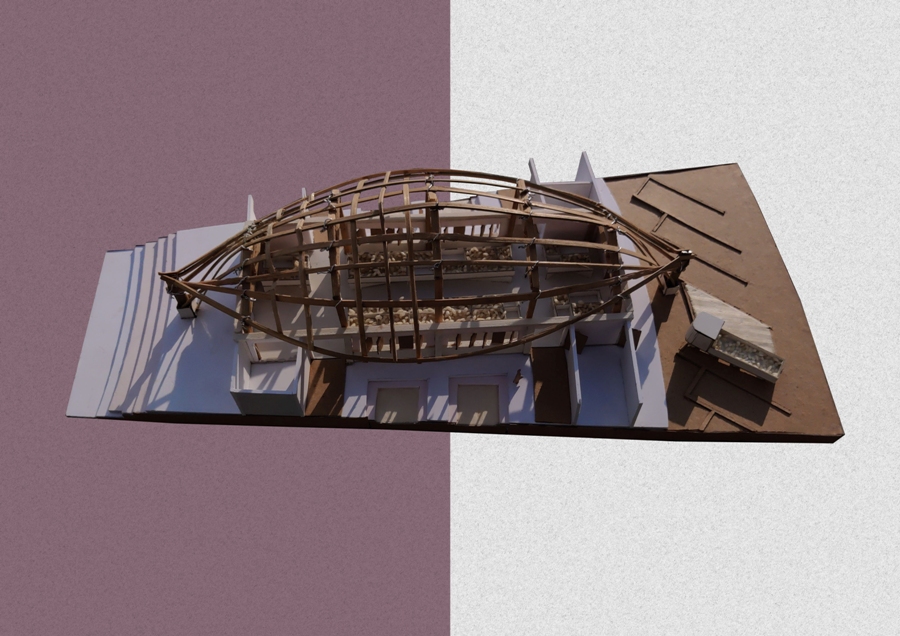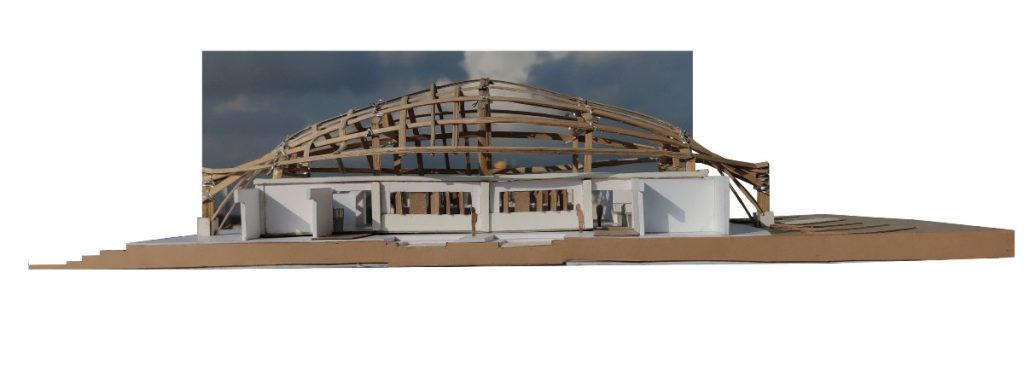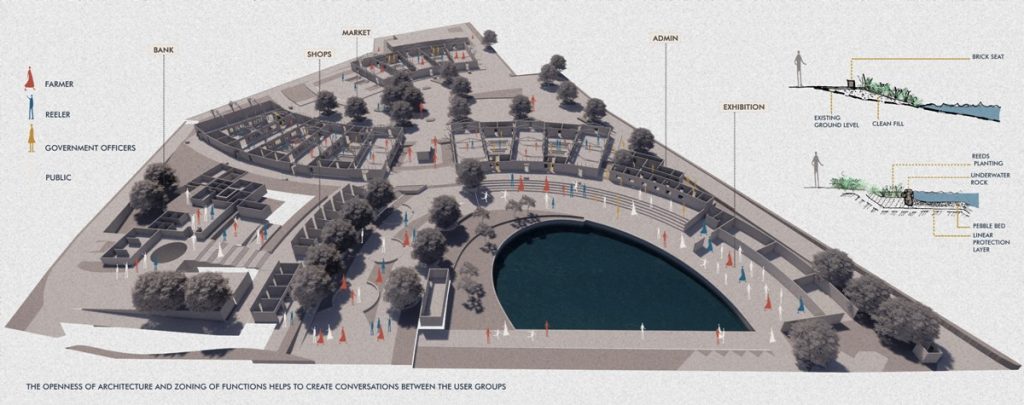From India’s Capital city New Delhi, the GEN Z Series travels to the Capital city of Karnataka State Bangalore to meet a 2022 B. Arch graduated architect Yuktha Mohan Gowda. She hails from the city. Yuktha Mohan Gowda reveals, “My parents, Mohan Gowda T and Champakamala M, have been a significant influence in my life. My father is a business man. My mother is a home maker. I have a younger sibling, who is pursuing her B.E degree in Artificial Intelligence.” As a student, Yuktha Mohan Gowda excelled academically and sports alike. Her active participation in all school activities saw Yuktha Mohan Gowda nurturing a deep love for nature and architecture. She confesses, “These passions define my journey (smiles).”

Physical Model of Market Block – Aerial View
Driven by a curiosity to understand and innovate, her pursuit of knowledge laid a strong foundation for Yuktha’s interests and career aspirations. She informs, “I thrived in sports, balancing physical activity with my academic pursuits. My commitment to sportsmanship led me to hold positions as a Prefect and House Captain for consecutive years. I am an avid nature enthusiast. Trekking through diverse landscapes allows me to appreciate the beauty of our natural world and fuels my curiosity about sustainable practices. My love for plants is profound. Understanding their role in ecosystems and their architectural significance inspires me to integrate organic elements into my design philosophy.”

Site Context
As an allrounder, Yuktha Mohan Gowda comes across as a warm person with a penchant for nature’s significance and balance. Her graduation thesis ‘Reshme Handara – Unifying Silk and its People, Ramnagara’ display her commitment and empathy towards the farmers’ community. Johnny D interacts with Yuktha Mohan Gowda to present her quest in the world of architecture.
What was your childhood ambition? Did you always wanted to become an architect?
As a child, I dreamt of becoming a scientist (smiles). I had a passion for both Science and Art. My father always instilled in me the desire to be different to make a difference. I really was not aware of Architecture as a profession at a young age. In my 9th Grade, I discovered through the show “Small Budget, Big Makeover”. My academic performance was excellent. I passed several exams like CET, NEET, JEE, ICAR, and KVPY, thereby giving me the freedom to choose any field. After extensive research, I chose architecture and felt it suited me the best.

Entrance of existing Cocoon Market
How has architecture influenced your life as a student?
Architecture has made me more responsible and organized, shaping my personality in ways that are evident in my designs. It has sparked my curiosity, turning each day into an opportunity for new learning and making me a constant learner, who enjoys discovering new things. It has also made me a keen observer. By the end of my thesis, I had become someone who believes in and is driven by processes. Any topic or conversations related to architecture filled me with pride knowing I can create an impact in the society and enhance living conditions through design and its processes. It is satisfying to be part of such a noble profession.

Site Plan
Briefly tell us about your University and the Course.
I graduated with a B. Arch degree from BMS College of Architecture in Basavangudi, a college affiliated with VTU, Belagavi, and recognized by the Council of Architecture, New Delhi. Located in the heart of the city, BMSCA has been a leader in architectural education for the last 40 years. The five-year Course included design studios and theory classes, blending the art and science of designing, planning and constructing buildings. The curriculum emphasized aesthetics, functionality, sustainability, human behavior and cultural relevance.

Physical Model of Market Block – Side View
Briefly describe the significance of your project with the ‘Title of the Project and Site Location’.
‘Reshme Handara – Unifying Silk and its People, Ramnagara’ project looks at markets as a synthesis of the culture and history of a region, as well as of the commercial relations with its neighbours. The objective of the project was to understand the typology of a market as a public centre of local communities.
The project also looks at rethinking the roles of markets in its setting as the new type of social area, supporting urban traditions and being the exchanging medium between communities not only economically, but also socially. The project aims re-development of the prestigious silk market situated in the silk city of Karnataka – Ramanagara, where sericulture farmers make the most of the city’s population.

Design Concept
Ramanagara hosts one of the country’s largest government cocoon markets, selling 40,000 to 50,000 kg of cocoons daily, sourced from farmers as distant as Bellary. This market, established in 1970 on a 2-acre plot, faces challenges like lack of accommodation, resting place, inadequate facilities and storage. A new 20-acre site along the highway has been allocated for redevelopment, out of which 7.6 acre is used for the design.
The design, influenced by local bamboo weavers supporting sericulture, reflects the site’s environmental factors, such as catchment area, sun and wind. Inspired by the cocoon’s ability to revert to its original shape under compression and tension, the market’s roof mimics this stability with its curved form.

Documentation of existing Cocoon Market
Which National or International architect has inspired / influenced you? Please specify as to why?
Tadao Ando, the Japanese architect, creates works with a deep connection between architectural space, light and nature. His Zen-like approach to design inspires me greatly! His architectural style demonstrates the power of simplicity and the thoughtful integration of the built environment with the natural world. I am motivated by his respect for nature and belief in the power of architecture to shape human experience and emotions.

Project Introduction, History and Context
As an Intern, what is the most important lesson(s) you have learned from senior architects, while being a part of a project?
During my internship at M9 Design Studio under Ar. Nischal Abhay kumar, I gained valuable insights into the use of steel as a material, both structurally and aesthetically. Working as a junior architect at Kham Design with Ar. Chetan Shivaprasad, I learned about the design process, client interaction and the responsibility of being involved in every phase of a project, thereby transforming a client’s dream into reality. Ar. Chetan Shivaprasad’s influence showed me how architecture can become a lifestyle. Working with him, I also developed organizing skills, learned to schedule weekly and monthly meetings and balance professional and personal life alike.

Area Programming
Hostile architecture is an eyesore and fast changing the urban landscape of prominent cities around the world. Architecture is meant to benefit the people / users at large, but the effects of hostile architecture are targeting people and depicting wickedness of the society and is against the ethos of architecture field. Elucidate your perspective about this unwanted trend in urban landscape.
Hostile Architecture highlights lack of social responsibility and undermines the potential of architecture to foster community, accessibility and positive human interactions. This unwanted trend in urban landscapes calls for a re-evaluation of our design philosophies to ensure they align with the true purpose of architecture: to serve and uplift all members of society.

Hostile Architecture: The Potential for Placemaking at the Node is Lost, Bangalore
Which significant aspects of the global platform ‘zerobeyond – the new frontier!’ did you liked the most, and why?
‘zerobeyond – the new frontier!’ offers an excellent platform for young architects and designers to share their views and stories. I find it particularly beneficial, as it allows us to read interviews from professionals around the globe. This global exposure reinforces our sense of purpose in the field and inspires us to continue creating impactful work and striving for greater achievements.

Plan and View of Entrance Plaza
The time to save Planet Earth from climatic catastrophes / human greed crisis has already slipped away from humans’ hands. Elucidate your views how the future of your generation is going to rise above the past generations to tackle this existential crisis?
My generation has the potential to rise above past generations to tackle this existential crisis by encouraging local communities to take action through initiatives like tree planting, community gardens and local clean-up projects, in which I even participate actively. Embracing and expanding renewable energy sources like solar, wind and hydro-electric power can significantly reduce our reliance on fossil fuels. Encouraging businesses to adopt sustainable practices by reducing carbon footprints and invest in green technologies is the way to combat Climate Change.

Site Sections
Local charm of cities has diminished due to Modern Architecture as every city looks alike and similar. How should architects / urban planners / landscape architects modernize cities, while maintaining the local charm intact?
Maintaining the local charm of cities while modernizing them requires a thoughtful approach from architects, urban planners and landscape architects. Instead of demolishing old structures, adaptive re-use allows architects to re-purpose existing buildings for modern uses, while retaining their historical and cultural significance. This approach honors the city’s heritage and reduces waste.

User Group Engagement
Architects should integrate elements of local architecture, materials, colors, building styles and emphasizing cultural heritage in designs. This helps buildings blend harmoniously with existing surroundings and preserves the city’s unique character. Also incorporating local craftsmanship and artistry not only supports the local economy, but also adds authentic cultural depth to architectural projects.

Other Blocks
Looking at the past in the current present, what are the futuristic architectural changes you would like to see in your home city / town? Elucidate the reasons for your vision.
I would like to see my hometown Bengaluru, incorporating more green building technologies to promote environmental sustainability and green corridors to combat urban heat island effects, thereby redesigning public spaces with more parks, pedestrian-friendly zones and cultural hubs to foster community interaction and well-being. New developments to maintain the city’s identity while embracing modernity is another aspects that I would like to see being implemented effectively.

View of the Market Modules
Honours and awards related to architecture, if any.
Decoding Everyday Market as public spaces Competition – Winner
It was conducted by Everyday City Lab.
VTU State Level Project Exhibition Competition Sristi 2022 – Shortlisted
My thesis project was exhibited for 3 days. It was a display of some of the best innovative projects across Karnataka by young graduating students.

Physical Model of the Project
IIA SRC Awards: B. Arch Thesis 2021-22- Nominated
It was a Thesis paneling at Latitude – Indian Institute of Architects – South Regional Conference (IIA-SRC) for best thesis award 2022.
Image Courtesy: Yuktha Mohan Gowda